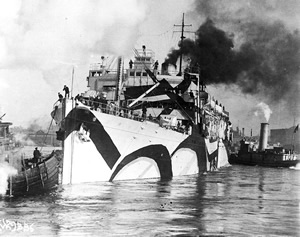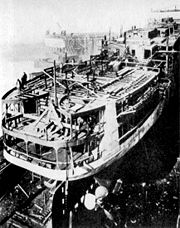USS Orizaba |
USS Orizaba (ID–1536) departing New York via the North River for France during World War I (1918)
Career (Ward Line)
Career (US)
General characteristics
|
USS Orizaba (ID-1536/AP-24) was a transport ship for the United States Navy during both World War I and World War II. She was the sister ship of Siboney but the two were not part of a ship class. During her varied career, she was also known as USAT Orizaba Orizaba made 15 transatlantic voyages for the Navy carrying troops to and from Europe in World War I with the second shortest average in-port turnaround time of all Navy transports. The ship was turned over to the War Department in 1919 for use as Army transport USAT Orizaba. After her World War I service ended, Orizaba reverted to the Ward Line, her previous owners. The ship was briefly engaged in transatlantic service to Spain and then engaged in New York – Cuba – Mexico service until 1939, when the ship was chartered to United States Lines. While Orizaba was in her Ward Line service, American poet Hart Crane leapt to his death from the rear deck of the liner off Florida in April 1932. During World War II, the ship was requisitioned by the War Shipping Administration and again assigned to the War Department as USAT Orizaba. After completing one voyage as an Army transport, the ship was transferred to the US Navy, where she was re- commissioned as USS Orizaba (AP-24). The ship made several transatlantic runs, was damaged in an air attack during the Allied invasion of Sicily, and made trips to South America. The transport also served in the Pacific Theatre, making several transpacific voyages, and one to the Aleutians. In June 1945, Orizaba was transferred under Lend-Lease to the Brazilian Navy where she served as Duque de Caxias (U-11). In August 1945, Duque de Caxis carried parts of the Brazilian Expeditionary Force from Naples back to Rio de Janeiro. The ship was badly damaged by a fire in 1947, but was repaired and remained in service. Permanently Orizaba —named after the town of Orizaba, Veracruz, Mexico —was laid down for the Ward Line by William Cramp & Sons Ship and Engine Building Company of Philadelphia, Pennsylvania and launched in February 1917. In mid-1917 the United States Shipping Board (USSB) commandeered and received title to all private shipbuilding projects in progress, including the still-incomplete Orizaba and her sister Orizaba under construction at William Cramp & Sons in Philadelphia, Pennsylvania, c. 1917 Assigned to the Atlantic Transport Service, Orizaba carried over 15,000 troops in six convoy trips to France before the end of World War I. During one such voyage, Orizaba 's executive officer, ordnance expert William Price Williamson , worked closely with Commander Richard Drace White— Orizaba 's commanding officer, himself an ordnance expert—to develop a workable depth charge launcher which would provide the Four days later on 21 August at 08:30, Orizaba, traveling with Siboney, spotted a submarine in the act of submerging. Orizaba attempted to ram the sub and dropped depth charges, but there was no indication that the attack was successful. In December 1918, she was temporarily assigned to assist the French government in repatriating French, Belgian, and Italian prisoners of war. Detached from that duty on 10 January 1919, she joined the Cruiser and Transport Force at Brest, and in nine voyages returned over 31,700 troops to the United States. After the completion of transport duty service in the summer of 1919, she decommissioned on 4 September and was turned over to the Army for further transport service as USAT Orizaba. The boat served in that According to the Statistical Department of the US Navy, Orizaba had the second-shortest average in-port turnaround time out of 37 US Navy transports used during World War I. The ship completed 15 round trips with an average turn-around time of just over 30 days per trip, while the overall Navy average was 39.8 days. |
Orizaba under construction at William Cramp & Sons |
Information obtained from: http://en.wikipedia.org/wiki/USS_Orizaba |

